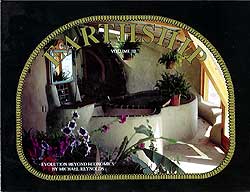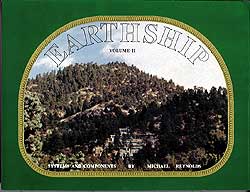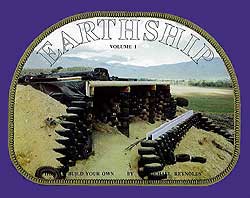FOUR: Natural Homes; ecologically sensible living
Below are books that are simply fantastic in the "new", environmentally friendly, home arena...
I've assembled the best of the best, in terms of all the books available. Check 'em out for yourself.
Keep this page open in your browser. It's much easier to scan through all of the books!
 The first section I have included is on the "Earthship" building style.
Click on the picture to the left to see the style of home that I am building in the near future.
Order the books below, which will give you the basic knowledge necessary for building your own, independent home. Although I am in total agreement to the concepts of the "Earthship" building process, I have augmented on the construction with one MAJOR addition - no matter what the books may say, there is NO thermal mass associated with old tires filled with sand! Take the time to visit the website of the "Earthship" (
http://www.earthship.org
), and review it carefully ( I suggest that you keep this browser window to my site open, and order the books through "Amazon.com", as the prices offered for the books are much lower than anywhere else that you will find!)...after you've been "hooked" on the building concept...take it a step further, and add some thermal mass to your home - by using poured CONCRETE and STONE to form your walls and foundation - this offers true THERMAL MASS! You can view an extraordinary website for truly "off-grid" passive solar homes and living at:
http://www.thenaturalhome.com/index.html
...this is the type of home that is pictured to the left.
The first section I have included is on the "Earthship" building style.
Click on the picture to the left to see the style of home that I am building in the near future.
Order the books below, which will give you the basic knowledge necessary for building your own, independent home. Although I am in total agreement to the concepts of the "Earthship" building process, I have augmented on the construction with one MAJOR addition - no matter what the books may say, there is NO thermal mass associated with old tires filled with sand! Take the time to visit the website of the "Earthship" (
http://www.earthship.org
), and review it carefully ( I suggest that you keep this browser window to my site open, and order the books through "Amazon.com", as the prices offered for the books are much lower than anywhere else that you will find!)...after you've been "hooked" on the building concept...take it a step further, and add some thermal mass to your home - by using poured CONCRETE and STONE to form your walls and foundation - this offers true THERMAL MASS! You can view an extraordinary website for truly "off-grid" passive solar homes and living at:
http://www.thenaturalhome.com/index.html
...this is the type of home that is pictured to the left.
![]() This is also the type of home that I , myself am building. I have taken most of the concepts provided through many years of research, from the "Earthship" type of building style, to passive solar homes, underground houses, solar-electric concepts, and, by combining this with "Archetara" (The Natural Home Building Source) and their truly revolutionary plans and concepts, I will end up with a distinctive, beautiful "off-grid" passive solar sustainable home, with a Tesla Turbine powering my primary back-up generator, of coarse ;) . I hope you enjoy all of the books offered. I wish you success with your new home building project. FDG
This is also the type of home that I , myself am building. I have taken most of the concepts provided through many years of research, from the "Earthship" type of building style, to passive solar homes, underground houses, solar-electric concepts, and, by combining this with "Archetara" (The Natural Home Building Source) and their truly revolutionary plans and concepts, I will end up with a distinctive, beautiful "off-grid" passive solar sustainable home, with a Tesla Turbine powering my primary back-up generator, of coarse ;) . I hope you enjoy all of the books offered. I wish you success with your new home building project. FDG
Here are the books for the "Earthship" building process:
 Comfort in Any Climate
Comfort in Any Climate
by Michael Reynolds
List Price:
$19.95
Our Price: $13.96
Comfort in Any Climate is about creating a comfortable space in any climate without the use of fossil fuels for heating and cooling. The book describes the difference between thermal mass and insulation, and how to apply these building components to a passive solar design. Comfort in Any Climate breaks down important sustainable design concepts into clear, easily understood elements: thermal mass, insulation, heating, cooling, and ventilation. Michael Reynolds, the author, has been designing and building sustainable buildings around the world for over thirty years. Based on this experience, the author uses architectural diagrams to show how buildings can tap into the temperature of the earth and relate to the angles of the sun. The book presents design variations from extreme cold to extreme heat, and addresses wet and dry climate considerations. Using examples of built Earthship designs, the author shows application of the presented concepts through text, illustrations and color photos. This book should be read by any person thinking of building or buying a home. It is informative to architects, builders, educators and any person interested in reducing their fossil fuel consumption. Includes eleven pages of color photos and architectural drawings that illustrate the beauty of buildings that passively heat and cool themselves, without the use of fossil fuels. Imagine a home that takes care of itself with no utility bills!
 Earthship : Evolution Beyond Economics
Earthship : Evolution Beyond Economics
by Mike Reynolds
List Price:
$24.95
Our Price: $17.46
Part 1, Evolutions...Chapter 1; Structure: Concrete and rammed earth half blocks. Aluminum can/ concrete bond beam and rebar pinned plates. Homemade trusses. Cold area ground insulation. Tire retaining walls and wing walls. Applications to steep land. New gutter details. Floors - mud and flagstone. Finishing Earth cliffs. Hanging Earthship doors. Round and arch windows. Homemade operable windows. Adding on a U module. Chapter 2; Mechanical: Indoor water cisterns. Water Organizing Module (WOM) Interior, Contained Greywater Treatment Planter, Power Organizing Modules (POM), Back propane heater. Part 2, New Components & Concepts...Chapter 3, Thermal Mass Refrigerator...Chapter 4, Solar Toilet...Chapter 5, Solar Oven/Distiller and electric cook top...Chapter 6, Straw Bale Temporary Structure...Chapter 7, Retrofit Applications, Part 3, Community & Urban Concepts...Chapter 8; Exploring Community Concepts...Chapter 9; Urban Earthships, Part 4, New Directions...Chapter 10; A Tire Building Code...Chapter 11; Aluminum Can Dome Pods...Chapter 12; Climatic & Site Adaptations...Chapter 13; The New Generics. This is a very good book encompassing the Earthship theories.
 Earthship : Systems and Components
Earthship : Systems and Components
by Michael Reynolds
List Price:
$24.95
Our Price: $17.46
Chapter 1, Solar Electric Systems, The operation of a sailboat requires an understanding of the concepts and schematics of sailing and knowing the patterns and nature of the wind. There are many differences between the operation of a gasoline powered speed boat and a wind powered sailboat. The major difference is that in a sailboat you will never run out of gas. Other differences involve pollution, noise, wear and tear, and repair of moving parts. The differences between conventional electricity and solar electricity in a home are similar to the difference between a speed boat and a sailboat. This chapter will cover the concepts and schematics of solar electric systems for Earthships. It will also discuss how to use a solar electric system relative to the patterns and nature of the sun, as discussed in chapter 2 of Earthship Volume I. Little attention will be given to specific wiring details, as these are covered in many electrical wiring manuals already in print (see Appendix, Chapter 1). The objective here is to provide the Earthship owner with an understanding of the nature of solar electricity, how it is collected and stored, and how to live with it. Chapter 2, Domestic Water Systems, In these times it is best to have and to be in control of your own water supply. Most city, town and community water systems (in addition to providing "questionable" water) are dependent on electricity for obtaining and delivering water. This makes the water dependent on commercial electricity. Commercial electricity looks unreliable for the future even if you can overlook the devastation that producing centralized commercial electricity brings. Therefore an Earthship must have its own water systems. This chapter will cover ways of acquiring and delivering water that use minimal or no electricity. As in the previous chapter the focus will be on the methodology and concept in an attempt to establish a clear understanding of how to get good water for domestic use. The equipment needed will be discussed but actual installation of the equipment, which involves conventional plumbing and mechanical skills, will be assumed to be within the grasp of local mechanical contractors and other consultants. Chapter 3, Waste Water Systems, With the given fact that water is becoming more and more precious due to careless consumption, contamination, and sheer numbers of humans on the planet, we must totally rethink what we do with waste water. The truth is there will be no such thing as waste water. This chapter will cover methods and concepts involved in recapturing and reusing all domestic water that is used in the dwelling. Chapter 4, Hot Water Systems, We have grown accustomed to the availability of all the hot water we can use. Maybe it is time to look at the reality of how much hot water we need. The Earthship Volumes are aimed at simple, comfortable survival not luxurious American decadence. There are many ways to get endless amounts of hot water for domestic purposes. There are but a few that are both economical and appropriate when one considers the numbers of people and the current condition of the planet in terms of extracted energy. Therefore, we will only discuss the few simple methods of obtaining hot water that, after twenty years of research in self-sufficient living, still look desirable both economically and ecologically. As with the previous chapter, we will first present a method of free hot water production which requires some personal changes of habit and attitude, then a method that comes a little closer to what we are accustomed to but is the lesser of the evils, so to speak. As for all the other methods of obtaining endless amounts of hot water, there are other books. Chapter 5, Lighting Systems, "And God said let there be light and there was light." Man said, let there be light and there were nuclear power plants, ugly power lines and radioactive waste. Lighting has become an expensive, (ecologically and economically) energy consuming endeavor in conventional housing. The objectives of Earthship lighting are to seriously reduce both expense and energy requirements for providing domestic light. In many cases the reduction of energy use has resulted in an increase in expense. This is because many of the new solar electric products do not have a large enough market to bring down the prices to a competitive and reasonable level. Another factor is that there are so many direction to go in terms of lighting (AC versus DC, incandescent versus fluorescent, etc.) and each direction has its own situation. The bottom line is that, at this point, no standard, simple, inexpensive direction for lighting has been established for solar dwellers. The purpose of this chapter, therefore, will be to establish this direction and to present the concept and equipment for simple, inexpensive "off the power grid" lighting. Chapter 6, Adobe Fireplace components, Most houses are kept too warm ( at the expense of the owner and the environment) by their various heating systems. It is much more healthy to keep an interior environment just a bit on the cool side.
 Earthship : How to Build Your Own
Earthship : How to Build Your Own
by Michael E. Reynolds
List Price: $24.95
Our Price: $17.46
Chapter 1, The Determining Factors of the Earthship Concept, This chapter will elaborate on and develop the "independent vessel" concept as a necessary spark toward the evolution of habitat on this planet. Chapter 2, Interfacing with local phenomena Location In the Northern Hemisphere, moss grows on the north side of trees and snow melts on the south side of mountains. If you want a log to float downstream, you must place it in the current, not near the shore in an eddy. Earthships must also be placed for optimum interaction with natural phenomena. This chapter explores the natural phenomena of the planet and explains how to interface an Earthship into the existing phenomena of the area. Chapter 3, Following the directives of concept and natural phenomena Design Fast cars are designed in wind tunnels, i.e. the wind dictates the design of the car. Likewise, natural phenomena dictate the design of an Earthship. The design schematic of existing Earthships is presented in this chapter as it relates to local phenomena. Within these parameters, personal needs and desires are dealt with. The issue of performance versus tradition is discussed from the perspective of "Live simply so that others may simply live." Chapter 4, The Skeleton of the vessel Structure Economy and availability to nonprofessional builders are important determinants of an Earthship structure. This chapter presents the simple structural integrity of existing prototype Earthships via conceptual diagrams, photographs and three dimensional drawings. This structural system is both designed and explained in terms to which the nonprofessional builder can relate. Chapter 5, The Primary building blocks of the vessel Materials The nature of the materials used to execute an Earthship design is explored. The earth-rammed automobile tire is presented as the most appropriate method for its strength, economy, lack of skill needed, and the fact that it makes use of an otherwise discarded "natural resource." The aluminum beverage can used as a masonry unit for filler walls is also presented for similar reasons. Chapter 6, The details and skills used to build the "U" module The "U" Module The fundamentals of how to build your own Earthship are presented here. A well illustrated and explained collection of easy to learn skills, available to all types of people of various strengths, shapes and sizes is presented. This includes how to lay the rammed earth tires, how to lay the aluminum cans in mortar, connections, mistakes commonly made, etc...
After you have dug your way through all of the information on "Earthships" , and visited the "Natural Home - Archetara" website, and now wish to be your own...your on your way to a lifestyle that is ecologically sensible, practical, and sustainable. Hope you enjoyed the information.